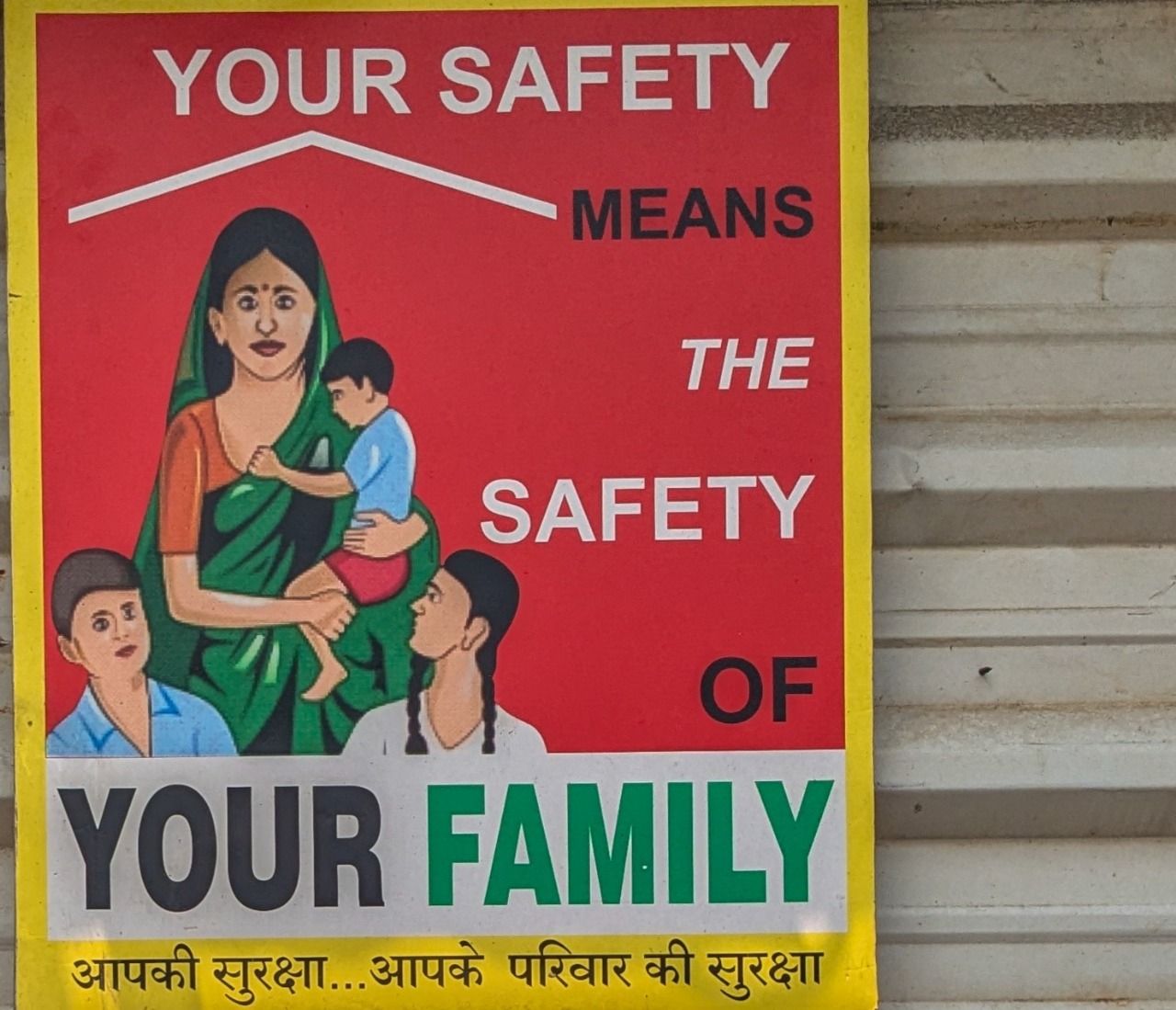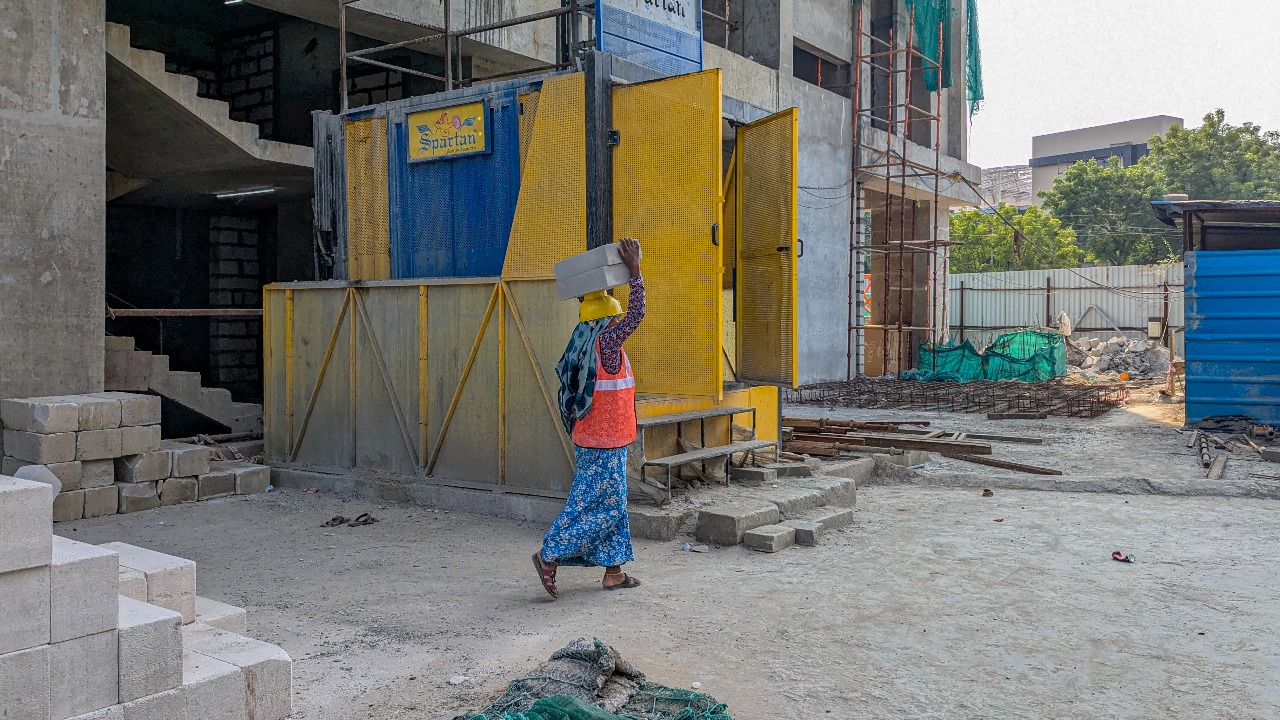Conversations about diversity, equity, and inclusion (DEI) typically emerge from and focus on white-collar workspaces. But what does it mean to extend this conversation to critically think about spaces occupied by daily wage workers, in spaces like construction sites? To explore this question, we spoke to Divya Ravindranath, a Senior Consultant at the School of Human Development, Indian Institute of Human Settlements (IIHS).
Divya’s research practice is situated at the intersection of informal labour and gender. Through her work, she advocates for stronger social protection systems for workers at construction sites among other sectors—particularly women with childcare needs. She has also contributed to research on breastfeeding and nutrition practices for migrant children in these spaces. In this conversation with Lab members, Gayatri Shanbhag and Pulakita Mayekar, Divya shares her insights about the challenges women working on construction sites encounter and raises a discussion about why a safe and supportive work environment for them matters.
(Editor’s Note: This interview was conducted in March 2025, and the conversation has been edited and condensed for clarity.)
What moved you to situate your research and academic practice at the intersection of gender, health practices, and informal work environments? What remains an anchor to continue this pursuit?
Divya: My path to this intersection of research was quite by accident. During my PhD, I had the opportunity to engage with a lot of public health courses. In the literature I was reading in labour studies, which was my main area of interest, health was an understudied piece. And from preliminary fieldwork, I realised there was much to explore on how someone’s position in the labour market shaped health outcomes.
So, in my dissertation, I decided to examine maternal and child health status and access to healthcare services among migrant households engaged in construction work. I found that there was an inter-generational impact of exposure to poor work and living conditions. A large proportion of children who migrated with their parents to worksites were malnourished and had little opportunity for early childhood development. With no exit, it was not uncommon for children to join the same labour force as their parents because they are not equipped to do anything else.
In subsequent projects since, I have examined the ‘triple burden of work’ that women experience as they do paid work, while shouldering the responsibilities of unpaid care work and domestic chores. My interest has specifically been on the challenges in caregiving in the absence of reliable care infrastructure. In such a situation, women are forced to make sub-optimal choices like leave the child alone at home or take them to the worksite. They have to constantly make a trade-off between earning a livelihood and caregiving. When we talk about increasing and sustaining women’s participation in the labour force, this is a critical piece that needs to be addressed. Over time, we have thought about practices and interventions to address these everyday challenges, and have engaged with workers’ organisations, unions, government and employers on this.
Your work in the informal sector extensively discusses the implications on child health when EBF (Exclusive Breastfeeding) is systemically denied during working hours. What constitutes EBF practices and how can one begin mapping daily infrastructural arrangements in the construction sector to meet these necessary healthcare needs?
Divya: There is enough scientific evidence that suggests that breastfeeding is important for the health of babies and mothers. But breastfeeding is time-intensive and economically costly— an aspect that is rarely acknowledged in public health messaging around it.
In India, the Maternity Benefits (Amendment) Act, 2017 mandates 26 weeks of paid maternity leave and the provision of childcare services. Both are employer responsibilities. But over 80% of our female labour force are in informal work; which means that the nature of employment or the employment relationship is informal. As a result, women don’t have maternity leave. And so, they return to work within a few days of childbirth to economically sustain their families. As I mentioned earlier, workers carry their children to work because they don’t have access to care infrastructure either.
At the worksite, while some contractors might out of benevolence allow women to pause their work and breastfeed, in most places, we have observed that women do not get adequate breaks. This means reduced number of breastfeeds and dependence on mixed-feeding. Women often breastfeed while working. I conducted a time-use study at construction sites, and found that to save time, women often breastfed their infants while working; carrying bricks or cement bags on their heads. This kind of immense mental and physical strain is untenable.
Securing the right to maternity leave for informal workers is going to be a long battle, and it is one that we must fight for. But in the meanwhile, when women are at work, employers can ease their stress by providing breastfeeding breaks and space to rest without it resulting in wage loss. Contractors must also be sensitised to reduce women’s workload when they are pregnant or breastfeeding. We have worked with NGOs that have tried to negotiate for this at some worksites and it has been possible
What must companies be mindful of while advocating for and mapping such healthcare infrastructure in the workplace?
Divya: Everyone deserves and must have the right to a dignified workspace. This includes availability of water, sanitation, and hygienic conditions. I know this sounds very basic, but unfortunately, even these most basic requirements are unavailable at most workspaces that employ workers informally.
Employers are aware that adverse climatic conditions and increased threat of vector-borne diseases impact their workforce. But to address this, it is absolutely critical that they provide better housing, conduct regular health checkups, and take steps to minimise environmental impacts. Small changes like adding insulation to the roof of labour housing can ease out climatic stress, for example.
An employer once told me that if there is one thing that they fear, it is delays in projects; and labour shortage is often the reason for it. For them, having a healthy labour force is an economic argument.


Glimpses from the field. Source: IIHS Media Lab
Do companies reach out to you for advice on how to provide women in construction work the same benefits as women in white collar workplaces; in the context of childcare, maternity benefits, and pension? What do you think it would take to make this a reality?
Divya: Globally, the construction industry is male-dominated. You find few women working as engineers or in management in this sector around the world. It’s the same in India as well; where the proportion of female workers that have formal jobs in construction is really small.
The industry is heavily dependent on migrant workers who are hired through a chain of contractors and sub-contractors. As an aside, I am yet to find a female contractor in my work! In fact, approximately seven to eight million women work in the construction industry in the lowest rung of jobs that are informal in nature. This is the broad landscape in which we are seeking to bring change.
A few companies reached out to us during the pandemic because there was a shortage of labour, and they were willing to provide facilities just so the workers would get back to work. A few years since then though, things are back to where they were.
The thing is, even though there are a lot of government schemes and programs that provide various kinds of benefits to workers, they don’t benefit from them. This is because workers spend 10-12 hours at the worksite with little time to register for social security benefits. And employers are unwilling to get involved because there is no employer-employee relationship; since workers are hired through a chain of contractors. Among the communities and employers that we work with, it takes several years of engagement before anything is done. There’s a lot of inertia in the early stages. The employers don’t think it is their responsibility—even if they are legally liable for any accident, injury or death at the worksite.
But, once the creches are functioning, the employers see tangible benefits. Over the years, we have worked closely with several NGOs and employers to facilitate childcare centres or creches at worksites. These centres are safe spaces that provide nutrition support and opportunities for engaging with material that is needed for early childhood development. The creches also improve women’s productivity and quality of work, and reduce absenteeism as children don’t fall sick frequently. Migrant workers also prefer to return to sites where creches are made available.
I have noticed that bigger companies are more willing to invest in creches as they want to be compliant with The Building and Other Construction Workers Act, 1996, and it also contributes to their brand image. Unfortunately, this is a small number. At most worksites there are no such facilities. And there is barely any monitoring or regulation on this front. This needs to change and we are trying to engage with as many employer organisations as possible to work on this challenge.
How would you encourage leadership, in construction and otherwise, to actively think through and make space for the healthcare practices that we just discussed?
Divya: Though we often hear that the role of the principal employer is minimal in informal work settings, migrant workers spend a vast majority of their time at worksites that are directly controlled by the employer. Even though social security schemes are provided by the government, migrants that live on worksites rarely have an opportunity to engage with the state in their everyday life. Under such circumstances, employers cannot be recused from their basic responsibilities. They must ensure occupational safety and health, provide creches, and strive to provide better living and working conditions.
There is enough scientific evidence that suggests that breastfeeding is important for the health of babies and mothers. But breastfeeding is time-intensive and economically costly— an aspect that is rarely acknowledged in public health messaging around it. In India, the Maternity Benefits (Amendment) Act, 2017 mandates 26 weeks of paid maternity leave and the provision of childcare services. Both are employer responsibilities. But over 80% of our female labour force are in informal work; which means that the nature of employment or the employment relationship is informal. As a result, women don’t have maternity leave. And so, they return to work within a few days of childbirth to economically sustain their families.